Antarctica

Photograph by
Jim Richardson
Even today,
Antarctica
overwhelms us. Already iconic, seared into our imaginations from the
tales of heroic exploration and tragic, fatal failure of the last
century, Antarctica overpowers us from afar, humbling even seasoned
travelers, more vast in reality than our imaginations can muster.
Relegated to obscurity at the bottom of our schoolroom globes, our scant
knowledge ill prepares us for the stunning outbursts of towering
mountain ranges ripping across the face of the deep blue sky, the
sublime blue and turquoise icebergs and glaciers, and the inconceivable
abundance of life. Indeed it is the limitless nesting colonies of
penguins, always comical but utterly indifferent to human visitors, that
ultimately define Antarctica as a world unto itself.
Iconic Shot: Besides penguins? Any view that encompasses Antarctica’s vast scale and distances.
Venice, Italy
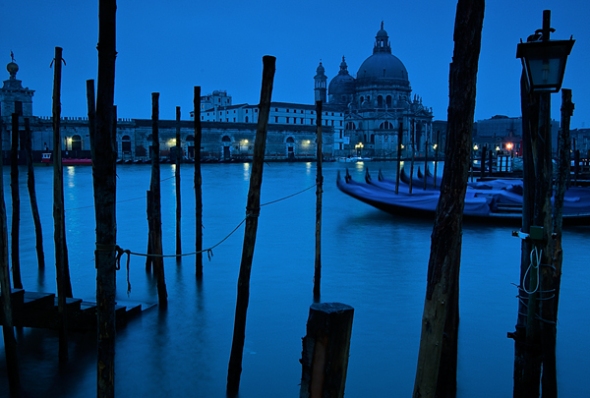
Photograph by
Jim Richardson
Graceful, beautiful, and constantly enchanting,
Venice
is also a prime example of the tragic, all-consuming lust for wealth,
power, and sordid ambitions. That all these contradictions coexist in
such a sumptuous milieu makes it, rightly, a destination synonymous with
worldly experience. “See Venice and die” puts the city squarely at the
ultimate conclusion of any bucket list. For the Victorians life was not
quite complete, youth not adequately finished until Venice was crossed
off the list. Yet it surmounts all the clichés; it’s never tawdry,
always remarkable. Today, this island city of lost hegemony is a museum
unto itself, a time capsule we can’t quite bear to relinquish. It is so
ravishing.
Iconic Shot: Gondolas on the Grand Canal
Machu Picchu, Peru
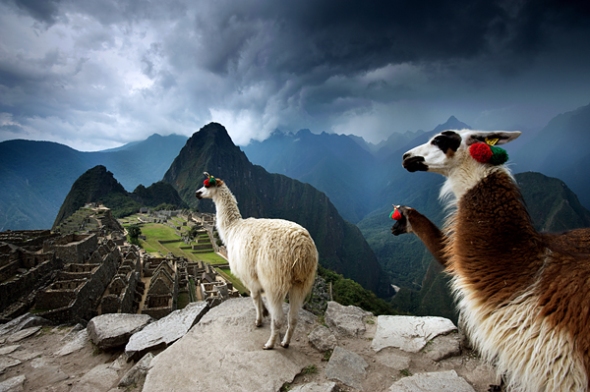
Photograph by
Jim Richardson
Machu Picchu, Peru
Photograph by Jim Richardson
Lost to most for 400 years under the encroaching jungle of the high Andes,
Machu Picchu’s
magic was rekindled after iconic explorer Hiram Bingham rediscovered it
in 1911 and brought it to the modern world. A century later it is still
astounding, evoking wonder for the Inca kings and their opulent retreat
in the high mountains, a stupendous sanctuary wrapped by surrounding
mountains, plunging valleys, and ever swirling clouds. Even the llamas
seem to be able to hear their ghosts. The stone houses and avenues, the
plazas and sacred sites all speak to us of life still present but
unseen.
Iconic Shot: From the terraces above, where Hiram Bingham made the original photographs for
National Geographic magazine
Stonehenge, England
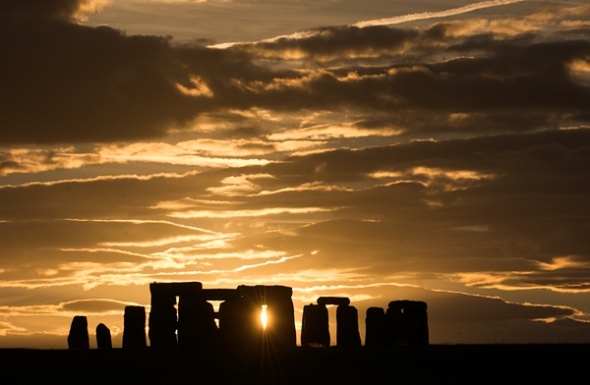
Photograph by
Jim Richardson
Few places invoke timelessness like
Stonehenge.
The absolute knowledge that every year for the past 5,000 years the
Earth, the sun, and Stonehenge have all lined up just so that the rays
of light glancing across the face of Salisbury Plain slip through the
upright stones— it sets our sense of cosmic order on fire. The rocks
hulk there, brawny yet graceful, set in place by crafty people we can
scarce imagine or recall. Then the moment is gone and we realize that
we, too, have been aligned, if only briefly, with time itself.
Iconic Shot: The sun’s rays intersecting with the stones in some way
Taj Mahal, India
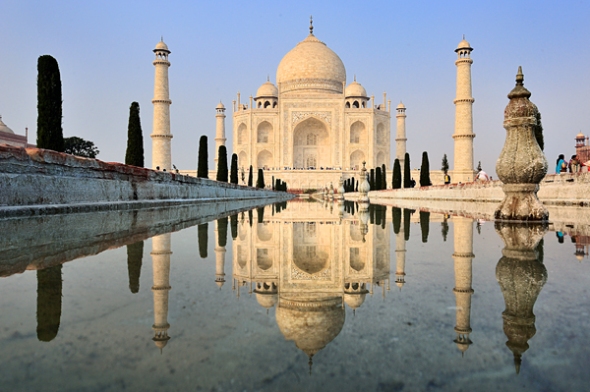
Photograph by
Jim Richardson
The
Taj Mahal
is famous for being beautiful (certainly), famous for being the symbol
of enduring love (perhaps,) and most of all famous for being famous.
Even if it were not sublime symmetry set in stone, its proportions
elegantly tempered by centuries of monumental building by the Mughal
rulers of central India, it would still beguile us for its place in the
history of world travel. For centuries it was
the “must see”
tourist sight of them all. Millions of photographs have been taken from
the exact same spot at the reflecting pool, each “perfect” in the same
way that the marble monument itself is perfect. In some ways taking that
picture is a pilgrimage of its own, seeing for oneself what millions of
others have also seen.
Iconic Shot: Down the reflecting pool, framing the Taj between the minarets
Easter Island
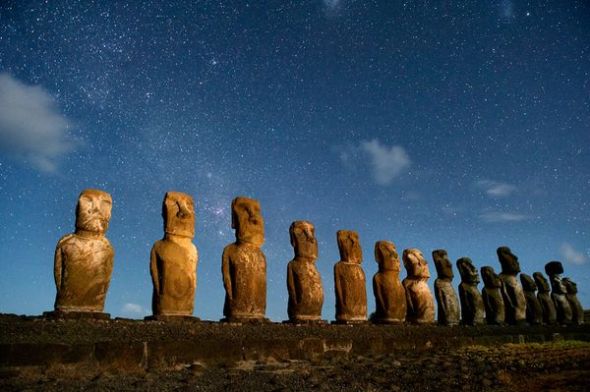
Photograph by
Jim Richardson
Standing in their haunting rows,
Easter Island‘s
statues, called moai, arouse our subconscious thoughts. The stone
statuary, at once unreal and yet known to us deeply, conjure up ancestor
worship in exactly the way the islanders, lost in the vast Pacific,
likely intended. Our imaginations reel at the solitude: Polynesians made
their epic journey across the vast Pacific to this speck of an island,
and then no one else came for nearly a thousand years. Left to their own
imaginings, the islanders invented their own version of eternity. In
the darkness, under the southern starry night, the hulking statues have
the power to haunt the mind like few other places on Earth.
Iconic Shot: Tongariki with the long row of moai looming above
Ta Prahm Temple, Cambodia
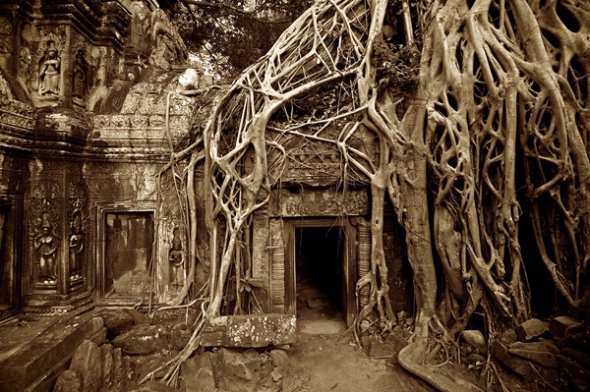
Photograph by
Jim Richardson
The temple of
Angkor Wat, rising out of the
Cambodian
jungle, is the world’s largest religious structure. But nearby is
another temple, Ta Prohm, less grand in scale but more penetrating to
the psyche. Here the roots of towering strangler figs cascade over the
intricately carved stone walls, framing doorways. They depend on each
other, neither the walls nor the trees able to stand without the other.
The roots snake over and around the religious symbols, looking like
synapses of some ancient central nervous system, connecting lost
thoughts set in stone.
Iconic Shot: The temple’s doors framed by roots
The Serengeti, Tanzania
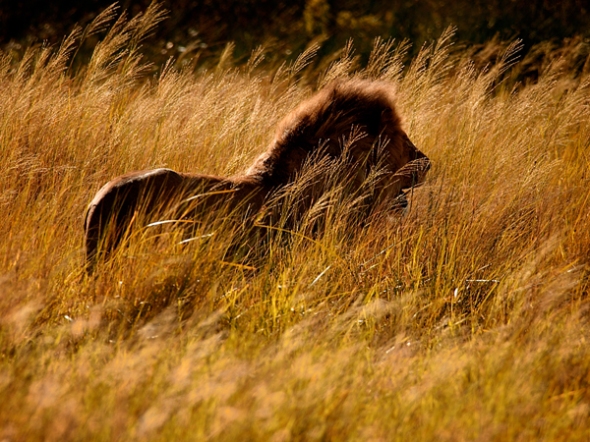
Photograph by
Jim Richardson
The Serengeti offers an epiphany to most visitors: Wildness still has
a place in our world. Out on the sun-drenched grasslands of
Tanzania,
life is elemental, the food chain obvious and unsentimental, the art of
survival an everyday thing, kindness and mercy totally without
relevance. The great migrations combine the many actors into a vast,
thronging drama. The immense vistas are tranquil but for the stalking
shape of a lion in the tall grass. We are intruders here redeemed by
accepting our insignificance. It is both humbling and comforting.
Iconic Shot: Symbolic views and shapes that evoke primeval emotions
The Pyramids of Giza, Egypt
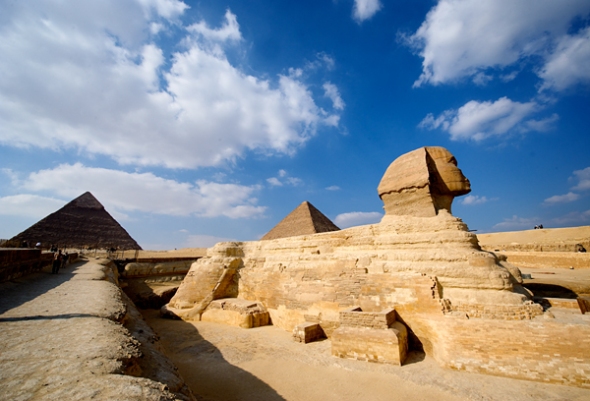
Photograph by
Jim Richardson
The
Pyramids
virtually define the concept of iconic, their very triangular shape
instantly recognized, seared into our collective human cultural
blueprint, defining place, time, and ethos. That shape! And so for some
4,500 years they have been the most wondrous of wonders, in a league of
their own, unchallenged for their sheer audacity, paragons of all
design. And then there is the Sphinx, a riddle evoking a mystery that we
don’t want solved. Lurking always, somehow more intriguing the less we
know about it, especially beguiling in old photographs when it was
buried up to its neck in the sands of the Egyptian desert. Tombs to
kings, monuments to human aspiration, all under the blazing Egyptian
sun.
Iconic Shot: Exploring their many alignments, from a distance for stacked shapes, up close for the intimate connections
Papua New Guinea
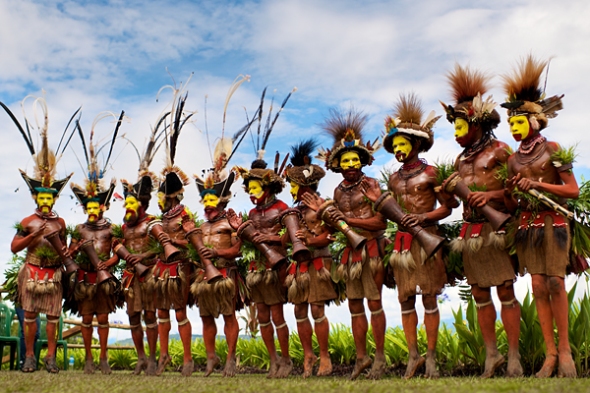
Photograph by
Jim Richardson
In the highlands of
Papua New Guinea
we come face to face with the parts of our mind that the modern world
has hidden away very well. The Huli Wigmen (and many other peoples and
cultures) carry forth traditions rooted deeply in time and mind,
dredging out inner spirits and (through intricate outfits and lavish
makeup) wearing them proudly at sing-sings. The transformation from
everyday folk to apparitions from the spirit world is astounding.
Looking into their faces we confront our own unresolved, fractured
nature. Throughout Papua New Guinea each group displays, with pride,
their own identity and inner being.
Iconic Shot: The faces in the dances, characters brought to life






























